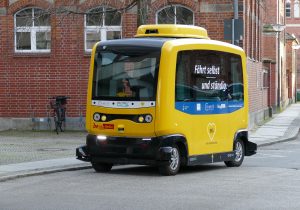Innovation alone is not sufficient to create a new market, the business model is vital. Dr Maurizio Catulli, of the University of Hertfordshire describes how customer insights can be used to consider the options and the potential market for new technologies.
Self-driving cars or Autonomous Vehicles (AV), are able to “sense” their environment and travel safely without human input. New technologies in this area are currently the focus of a sizeable investment from automotive providers and policy makers.
The British Automated and Electric Vehicles Act 2018 defines a vehicle as “driving itself” if it is “operating in a mode in which it is not being controlled, and does not need to be monitored, by an individual”. Such vehicles use on board computer, Artificial Intelligence (AI), high-resolution cameras and LIDAR (light detection and ranging) to navigate the landscape. Another class of AVs, Connected Autonomous Vehicles (CAV), rely on information on traffic congestion and safety hazards obtained from other vehicles in the vicinity and roadside units to interpret situations.

Although fully Autonomous Vehicles are not yet for sale at present, small-scale ‘demonstrator’ offerings such as Waymo (an offspring of Google), General Motors Cruise, Tesla and Über are operational in defined areas such as Arizona and targeted to pools of selected people.
Increasingly interest is focusing not just on the market for AV’s for individual ownership but also using shared AVs or CAVs as part of a ‘Mobility as a Service’ system. With this offering, people can book rides on self-driving cars, using them as personal taxis. The big question remains ‘is this a viable business model?’
Reasons for the interest in autonomous vehicles

Environment: Traditional private cars contribute to fatalities and injuries through accidents and are a source of air pollutants. In contrast, proposers claim that low emission AVs and CAVs, can bring environmental benefits by reducing the number of private cars in circulation. Additionally, replacing human drivers with advanced sensing and communications technologies will reduce human error and lead to a reduction in crashes and fatalities.
Productivity: People would be able to conduct activities other than driving such as working on their computers whilst they are travelling increasing personal productivity.
Convenience: Compared with other types of shared mobility, such as car clubs, AVs could possibly deliver the first and last mile as once they are booked they could go and collect the travellers directly from home; avoiding the inconvenience of finding and accessing vehicles.
Inclusivity: AVs offer greater accessibility to disadvantaged groups that cannot drive, such as people with disabilities including blind people and the elderly. AVs could also serve younger people who cannot afford to buy cars or without a driving license. However, this may undermine environmental benefits, by increasing the number of vehicles on the road instead or reducing it. Furthermore, employees who normally walk, cycle or use public transport could be interested in travelling faster for work, so increasing the number of vehicles in circulation.
What could go wrong with Autonomous Vehicles?
The success or otherwise of AVs is linked to public acceptance. Research on shared mobility and AVs point at hard obstacles that could hamper diffusion of AVs:
Safety: In order for people to buy self-driving cars and vote for the government to allow them on roads, the technology must be trusted as safe. Instead, AVs have had a bad press, as the first of five known fatal crashes of an AV took place in in 2016.
Hygiene: A further complication recently arose because of the coronavirus pandemic. Shared mobility involves serial sharing – when travellers sequentially travel on vehicles – and simultaneous sharing – when travellers share a vehicle at the same time with other passengers. In the former case, passengers would not know who has travelled on a vehicle before them. In the latter case, passengers could potentially share a booked vehicle with strangers. Fear of the pandemic could potentially dissuade passengers from using AVs shared services.
Standards: Even before the pandemic, research had shown that consumers are diffident of shared vehicles, including AVs, for fear of contagion. Consumers expect to find a car they have booked dirty or damaged and in the case of electric cars, uncharged, so they would not be able to use the vehicle.
Need for skills: In some cases, AVs will not be totally autonomous and might require human intervention in emergencies that the vehicle’s management system cannot process. People might be incapable or unwilling to take over the drive. In the long term, deskilling might even render passengers unable to take over. The issue of AV malfunction would also negate the advantages of inclusivity of MaaS, this indeed requires far more research both on the technology and on whether people unable to drive AVs could help the most would actually trust the technology.
Practice Theory and Consumer Culture Theory
Original socio-anthropological research on shared mobility outlines issues that would be relevant to shared AVs. This research was informed by a sociological perspective called Practice Theory, which focuses on social practices – what people do in their daily lives – and an anthropological perspective called Consumer Culture Theory, which focuses on the identities people project when they consume. Data collected through personal user interviews and observations in accompanied drives supported the research.
The results suggest that driving is a very social phenomenon and an activity through which drivers project their image toward their social network. Drivers project their identities through drawing symbolic value from driving private cars not only to appear successful through their ability to own their vehicles but also to show their capability of helping other people in their social network to travel to venues such as hospital appointments, possibly with little notice or in emergency. Indeed, consumers tend to think that use of AVs to travel would not gain respect and recognition amongst their friends and colleagues in their communities.
Drivers also draw hedonic value – pleasure – from driving cars and AVs could not deliver on this. Numerous studies found that people enjoy driving manually and state that they are against spending on automated systems. There is then a concern for liability for damages caused by accidents, speeding fines etc.
Another problem with shared AV diffusion is the change in practices that they would require of drivers / passengers and the associated issues of trust. Automobility supports other activities drivers perform, such as work, leisure and shopping. Within these activities, private cars deliver a sense of control and independence which people resist relinquishing, which makes breaking the dominance of private cars difficult. Passengers, for example, would need to book AVs and other vehicles using smartphone apps and people mention difficulties such as remembering log in names and passwords to access the service.
Importantly, people are nervous about the safety and security of AVs, being in user lists and have concerns about privacy and mass surveillance, as well as risk of malware and hacking, which could potentially lead to accidents. This links to a general distrust of the technology or even to technophobia. Furthermore, not all passengers might feel safe to travel with strangers. A woman, for example, might not feel safe using a driverless vehicle without a human driver to protect her from potentially harassing travellers. Indeed, AVs seem to resonate more with men than with women.
In short, mobility by AVs might just not be for everybody. Indeed, this and other studies show that younger, educated consumers with interests in environmental protection and even students might be the best targets because they are less interested in or able to purchase cars and because of their skills in using smartphone apps to book the AVs. A minority of drivers interviewed stated that they considered environmental benefits so important that they outweighed risks or indeed the extra work necessary to cover the first and last mile, for example walk to places where a vehicle could pick them up. This minority interest might mean that If MaaS, including AVs, were to diffuse, it might remain a niche application.
How can AV provision be shaped?
Diffusion of AVs depends on whether they can develop from the current demonstrator projects to “capillary” coverage.
One of the questions proposed by researchers is whether shared AVs would work together with traditional automobility as in traditional public transport, enhance it or radically oppose it. For the reasons illustrated in the above paragraphs, shared AVs, if they really develop into a viable offering, might share roads with traditional drivers and therefore remain a niche offering.
Finally, the coronavirus pandemic has actually caused falls in demand for car and bicycle sharing and this would affect MaaS and EVs. The additional work required to clean vehicles affected profitability, leading to reduction in service and mergers between car and bicycle sharing providers. Shared AVs therefore need safety and communication measures to address issues such as fear of contagion – whether connected or not to the coronavirus – and trust in technology, providers and other users. These measures would need to be certified with robust quality assurance processes to protect the consumers and guarantee the service.
Further reading
Capturing the behavioural determinants behind the adoption of autonomous vehicles
Is it who you are or what you do? Insights for Mobility as a Service from research on a car club
User decision-making in transitions to electrified, autonomous, shared or reduced mobility
About the author: Maurizio Catulli
Dr. Maurizio Catulli is a Senior Lecturer at the University of Hertfordshire. His research interests include Mobility as a Service and sustainable transport, Product Service systems (PSS), sustainable production & consumption, the circular and sharing economies and their persistence in a post-coronavirus world. Maurizio led several research and consultancy projects across the automotive, pharmaceutical, electronics and defence industries.
At The University of Hertfordshire, he lectures in Managing Change for Environmental Management and Solving Environmental Problems and from September 2021, he will lecture on a new MSc in Transport Planning. He led several “live” client consultancy projects, including UK Government funded Knowledge Transfer Partnerships (KTP). Maurizio has led REBUS, a project on sustainable consumption funded by DEFRA and which deployed academic staff from Environmental Sciences, Creative Arts, Psychology and Engineering Schools.

